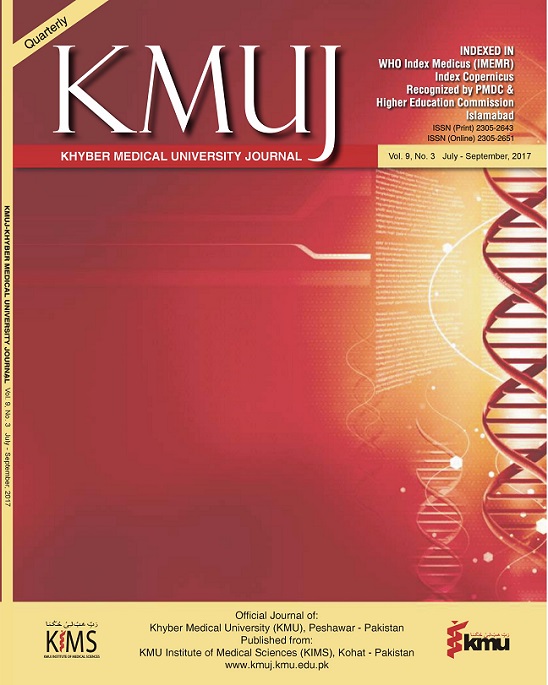PSYCHO-SOCIAL IMPACT OF ARMY PUBLIC SCHOOL TERRORIST ATTACK ON HIGH SCHOOL CHILDREN IN DISTRICT PESHAWAR, KHYBER PAKHTUNKHWA, PAKISTAN
Main Article Content
Abstract
OBJECTIVE: To determine the psycho-social impact of Army Public School Terrorist attack on high school children in district Peshawar, Khyber Pakhtunkhwa (KP), Pakistan.
METHODS: This cross-sectional study was conducted in government and private high school children from March to August 2015. Four hundred and twenty children were equally selected from both government and private high schools through stratified random sampling. The data was collected using psychometric tools, including Impact of Event Scale-Revised (IES-R) and Strength and Difficulty Questionnaire (SDQ). Pearson's chi-squared test was used to determine the association between the age, gender and psychological and social problems.
RESULTS: Total 420 students in the age group of 13 to 16 years were included in the study, in which 210 (50%) were males and 210 (50%) were females. Out of the 420, 59 (14%) showed avoidance, 46 (11%) intrusion and 38 (9%) had hyper-arousal. Scores of >33 were shown by 59 (14%) children that mean 14% of the children had some sort of psychological problem. Social problems were shown by 17 (4%) children while 21 (5%) were at risk of developing such problems.
CONCLUSION: High school children in district Peshawar Pakistan, had both psychological and social problems along with risk of developing such problems after the tragic event, which suggested a need of psycho-social relief activities in the schools, in order to bring back the students to their normal life.
KEY WORDS: Psycho-social Impact (Non-MeSH); High School Children (Non-MeSH); Adolescent (MeSH); Terrorism (MeSH); Pakistan(MeSH); Army Public School Terrorist attack (Non-MeSH).
Article Details
Work published in KMUJ is licensed under a
Creative Commons Attribution 4.0 License
Authors are permitted and encouraged to post their work online (e.g., in institutional repositories or on their website) prior to and during the submission process, as it can lead to productive exchanges, as well as earlier and greater citation of published work.
(e.g., in institutional repositories or on their website) prior to and during the submission process, as it can lead to productive exchanges, as well as earlier and greater citation of published work.
References
Ahmed MB. Effects of terrorism on children: Psychosocial biological understanding. J Islamic Med Assoc North Am 2010 Sep 27;39(2):65-72.
The National Consortium for the Study of Terrorism and Responses to Terrorism (START). AL-shabaab Attack on Garissa University in Kenya. START 2015. [Cited on February 10, 2016] Available from URL:
http://www.start.umd.edu/pubs/STARTBackgroundReport_alShabaabGarissaU_April2015.pdf
McDaniel MC, Ellis CM. The Beslan hostage crisis: A case study for emergency responders. J Appl Secur Res 2009;4(1): 21-35.
The National Consortium for the Study of Terrorism and Responses to Terrorism (START). Terrorist Attack on Educational Institutions. START 2014. [cited on February 12 ,2016]. Available from URL: https://www.start.umd.edu/pubs/Peshawar%20School%20Background%20Report%20December%202014.pdf
The Economist (2015). Pakistan after the Peshawar school massacre. The Man with a Plan. [Cited on February 12, 2016]. Available from URL: http://www.economist.com/news/asia/21640380-army-back-countrys-driving-seat-man-plan
Air University. Psychological Impact of Terrorist Attack: Lessons learned for future attacks 2011. [Cited on February 13, 2016]. Available from URL: http://www.au.af.mil/au/awc/awcgate/cpc pubs/hlspapers/mathewson.pdf
Invisible wounds: Impacts of War and Terrorism on Children 2013. [Cited on February 14, 2016]. Available from URL: http://blogs.jpmsonline.com/2013/09/05/invisible-wounds-impacts-of-war-and-terrorism-on-children/
Martikainen P, Bartley M, Lahelma E. Psychosocial Determinants of Health in Social Epidemiology. Int J Epidemiol 2002;31(6):1091-3.
Talking to our children about Violence and Terrorism: Living in Anxious Times. The Center for Social and Emotional Education. [Cited on February 18, 2016]. Available from URL: http://www.schoolclimate.org/parents/documents/Talking_to_our_chidren_about_Violence_and_terrorism.pdf
Kumar U, Mandal MK. Countering Terrorism: Psychosocial Strategies. New Dehli: SAGE Publications India; 2012. p.85. ISBN-10: 8132109597
Teacher-Parent Communication: Dos and Don, t.education.com. [Cited on February 20, 2016]. Available from URL: http://www.education.com/slideshow/teacher-parent-communication-slideshow/
Social and psychological consequences of violence in FATA. FATA Research Center 2013. [Cited on February 25, 2016]. Available from URL: http://frc.com.pk/wp-content/uploads/2014/05/SPCV-in-FATA.pdf
Impact of Event Scale-Revised (IES-R). PTSD: National Center for PTSD 1996. [Cited on February 26, 2016]. Available from URL: http://www.ptsd.va.gov/professional/assessment/adult-sr/ies-r.asp
Strengths and Difficulties Questionnaire (SDQ). Youth in Mind 2012. [cited on February 27, 2016]. Available from URL: http://www.sdqinfo.com/
Moscardino U, Scrimin S, Capello F, Altoè G, Axia G. Psychological adjustment of adolescents 18 months after the terrorist attack in Beslan, Russia: A cross-sectional study. J Clin Psychiatry 2008;69(5):854-9.
Graeff-Martins AS, Hoven CW, Wu P, Bin F, Duarte CS. Use of mental health services by children and adolescents six months after the World Trade Center attack. Psychiatr Serv 2014;65(2):263-5.
Nordanger DØ, Hysing M, Posserud MB, Lundervold AJ, Jakobsen R, Olff M, et al. Posttraumatic responses to the July 22, 2011 Oslo terror among Norwegian high school students. J Trauma Stress 2013; 26(6):679-85.
Comer JS, Dantowitz A, Chou T, Edson AL, Elkins RM, Kerns C, et al. Adjustment among area youth after the Boston Marathon bombing and subsequent manhunt. Pediatrics 2014;134(1):7-14.
T A. Terrorist Attack and Community Responses. General Report. Islamabad: Pak Institute for Peace Studies; 2010. [cited on February 06, 2016]. Available from URL :http://pakistansocietyofvictimology.org/Userfiles/Terrorist%20attacks%20and%20Community%20Responses%20in%20Pakistan.pdf
Ahmed AE, Masood K, Dean SV, Shakir T, Kardar AA, Barlass U, et al. The constant threat of terrorism: stress levels and coping strategies amongst university students of Karachi. J Pak Med Assoc 2011;61(4):410-4.
Nasim S, Khan M, Aziz S. Impact of terrorism on health and Hospital Anxiety Depression Scale Screening in medical students, Karachi, Pakistan. J Pak Med Assoc 2014;64(3):275-80.
Bonanno GA, Brewin CR, Kaniasty K, Greca AM. Weighing the costs of disaster: Consequences, risks, and resilience in individuals, families, and communities. Psychol Sci Public Interest 2010;11(1):1–49.
Hoven CW, Duarte CS, Mandell DJ. Children’s mental health after disasters: The impact of the World Trade Center attack. Curr Psychiatry Rep 2003;5(2):101–7.
Pat-Horenczyk R, Abramovitz R, Peled O, Brom D, Daie A, Chemtob CM. Adolescent exposure to recurrent terrorism in Israel: posttraumatic distress and functional impairment. Am J Orthopsychiatry 2007;77(1):76-85.
Shahar G, Cohen G, Grogan KE, Barile JP, Henrich CC. Terrorism-related perceived stress, adolescent depression, and social support from friends. Pediatrics 2009;124(2):235-40.
